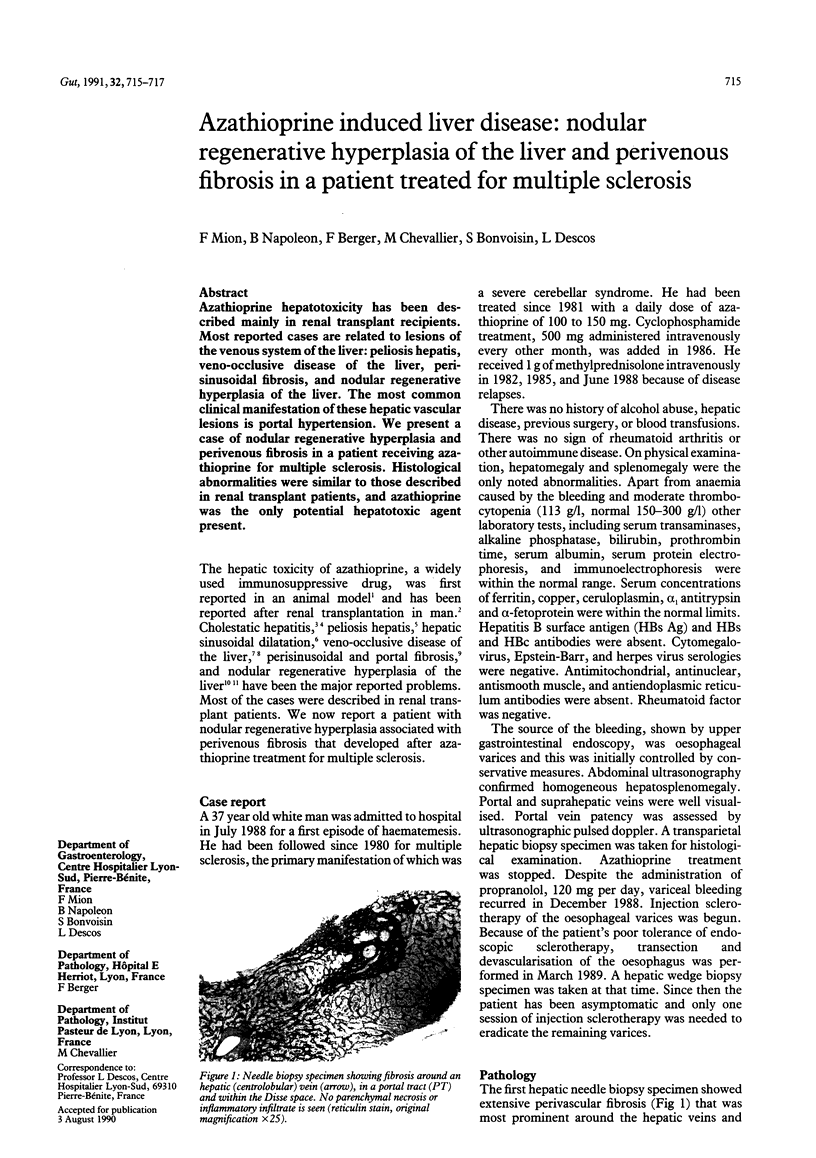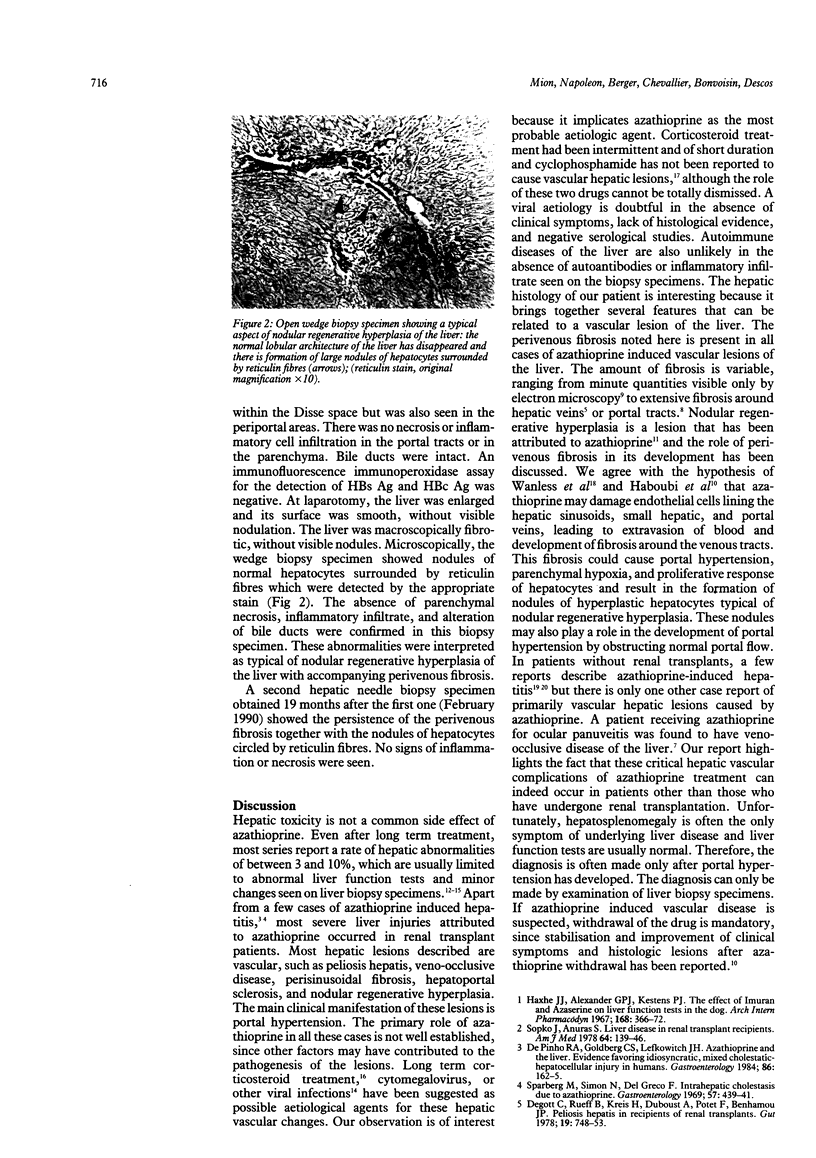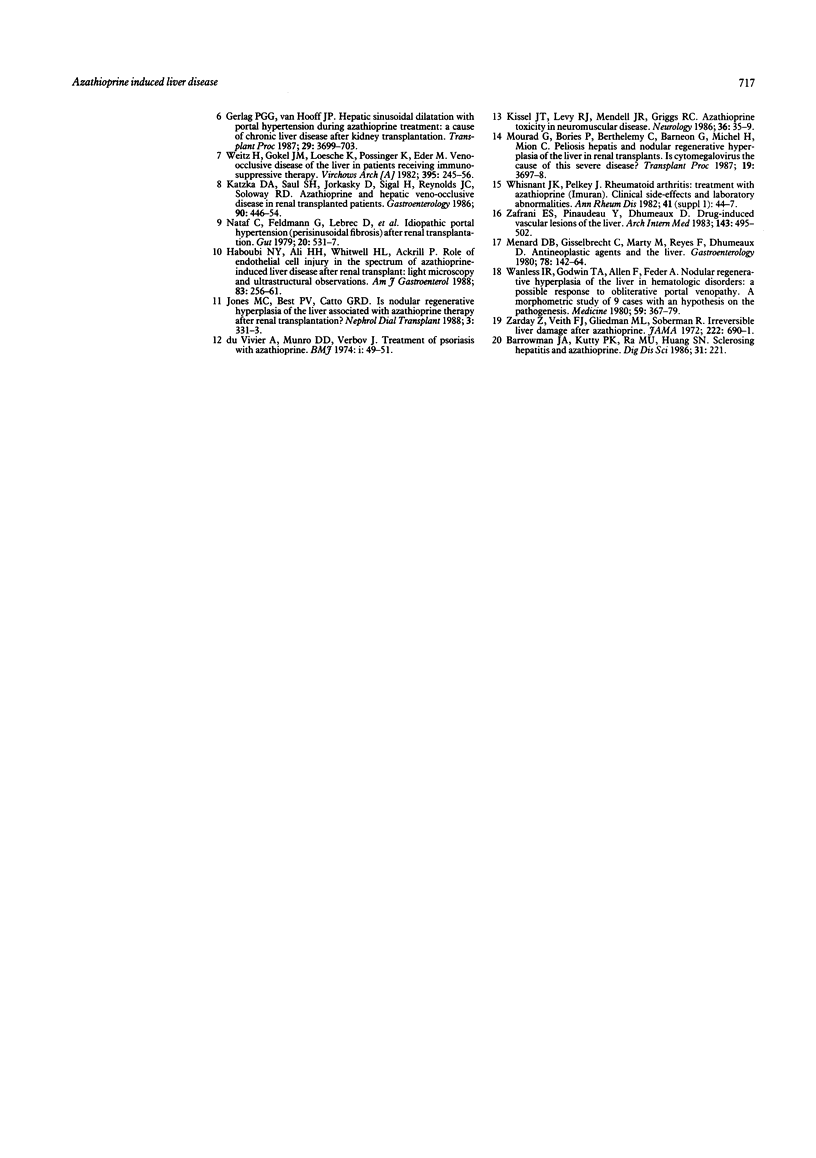Abstract
Azathioprine hepatotoxicity has been described mainly in renal transplant recipients. Most reported cases are related to lesions of the venous system of the liver: peliosis hepatis, veno-occlusive disease of the liver, perisinusoidal fibrosis, and nodular regenerative hyperplasia of the liver. The most common clinical manifestation of these hepatic vascular lesions is portal hypertension. We present a case of nodular regenerative hyperplasia and perivenous fibrosis in a patient receiving azathioprine for multiple sclerosis. Histological abnormalities were similar to those described in renal transplant patients, and azathioprine was the only potential hepatotoxic agent present.
Full text
PDF


Images in this article
Selected References
These references are in PubMed. This may not be the complete list of references from this article.
- Barrowman J. A., Kutty P. K., Ra M. U., Huang S. N. Sclerosing hepatitis and azathioprine. Dig Dis Sci. 1986 Feb;31(2):221–222. doi: 10.1007/BF01300713. [DOI] [PubMed] [Google Scholar]
- Degott C., Rueff B., Kreis H., Duboust A., Potet F., Benhamou J. P. Peliosis hepatis in recipients of renal transplants. Gut. 1978 Aug;19(8):748–753. doi: 10.1136/gut.19.8.748. [DOI] [PMC free article] [PubMed] [Google Scholar]
- Du Vivier A., Munro D. D., Verbov J. Treatment of psoriasis with azathioprine. Br Med J. 1974 Jan 12;1(5897):49–51. doi: 10.1136/bmj.1.5897.49. [DOI] [PMC free article] [PubMed] [Google Scholar]
- Gerlag P. G., van Hooff J. P. Hepatic sinusoidal dilatation with portal hypertension during azathioprine treatment: a cause of chronic liver disease after kidney transplantation. Transplant Proc. 1987 Oct;19(5):3699–3703. [PubMed] [Google Scholar]
- Haboubi N. Y., Ali H. H., Whitwell H. L., Ackrill P. Role of endothelial cell injury in the spectrum of azathioprine-induced liver disease after renal transplant: light microscopy and ultrastructural observations. Am J Gastroenterol. 1988 Mar;83(3):256–261. [PubMed] [Google Scholar]
- Haxhe J. J., Alexandre G. P., Kestens P. J. The effect of Imuran and Azaserine on liver function tests in the dog. Its relation to the detection of graft rejection following liver transplantation. Arch Int Pharmacodyn Ther. 1967 Aug;168(2):366–372. [PubMed] [Google Scholar]
- Jones M. C., Best P. V., Catto G. R. Is nodular regenerative hyperplasia of the liver associated with azathioprine therapy after renal transplantation? Nephrol Dial Transplant. 1988;3(3):331–333. [PubMed] [Google Scholar]
- Katzka D. A., Saul S. H., Jorkasky D., Sigal H., Reynolds J. C., Soloway R. D. Azathioprine and hepatic venocclusive disease in renal transplant patients. Gastroenterology. 1986 Feb;90(2):446–454. doi: 10.1016/0016-5085(86)90947-9. [DOI] [PubMed] [Google Scholar]
- Kissel J. T., Levy R. J., Mendell J. R., Griggs R. C. Azathioprine toxicity in neuromuscular disease. Neurology. 1986 Jan;36(1):35–39. doi: 10.1212/wnl.36.1.35. [DOI] [PubMed] [Google Scholar]
- Mourad G., Bories P., Berthelemy C., Barneon G., Michel H., Mion C. Peliosis hepatis and nodular regenerative hyperplasia of the liver in renal transplants. Is cytomegalovirus the cause of this severe disease? Transplant Proc. 1987 Oct;19(5):3697–3698. [PubMed] [Google Scholar]
- Ménard D. B., Gisselbrecht C., Marty M., Reyes F., Dhumeaux D. Antineoplastic agents and the liver. Gastroenterology. 1980 Jan;78(1):142–164. [PubMed] [Google Scholar]
- Nataf C., Feldmann G., Lebrec D., Degott C., Descamps J. M., Rueff B., Benhamou J. P. Idiopathic portal hypertension (perisinusoidal fibrosis) after renal transplantation. Gut. 1979 Jun;20(6):531–537. doi: 10.1136/gut.20.6.531. [DOI] [PMC free article] [PubMed] [Google Scholar]
- Sopko J., Anuras S. Liver disease in renal transplant recipients. Am J Med. 1978 Jan;64(1):139–146. doi: 10.1016/0002-9343(78)90190-0. [DOI] [PubMed] [Google Scholar]
- Wanless I. R., Godwin T. A., Allen F., Feder A. Nodular regenerative hyperplasia of the liver in hematologic disorders: a possible response to obliterative portal venopathy. A morphometric study of nine cases with an hypothesis on the pathogenesis. Medicine (Baltimore) 1980 Sep;59(5):367–379. [PubMed] [Google Scholar]
- Weitz H., Gokel J. M., Loeschke K., Possinger K., Eder M. Veno-occlusive disease of the liver in patients receiving immunosuppressive therapy. Virchows Arch A Pathol Anat Histol. 1982;395(3):245–256. doi: 10.1007/BF00429351. [DOI] [PubMed] [Google Scholar]
- Whisnant J. K., Pelkey J. Rheumatoid arthritis: treatment with azathioprine (IMURAN (R)). Clinical side-effects and laboratory abnormalities. Ann Rheum Dis. 1982;41 (Suppl 1):44–47. doi: 10.1136/ard.41.suppl_1.44. [DOI] [PMC free article] [PubMed] [Google Scholar]
- Zafrani E. S., von Pinaudeau Y., Dhumeaux D. Drug-induced vascular lesions of the liver. Arch Intern Med. 1983 Mar;143(3):495–502. [PubMed] [Google Scholar]
- Zarday Z., Veith F. J., Gliedman M. L., Soberman R. Irreversible liver damage after azathioprine. JAMA. 1972 Nov 6;222(6):690–691. [PubMed] [Google Scholar]




